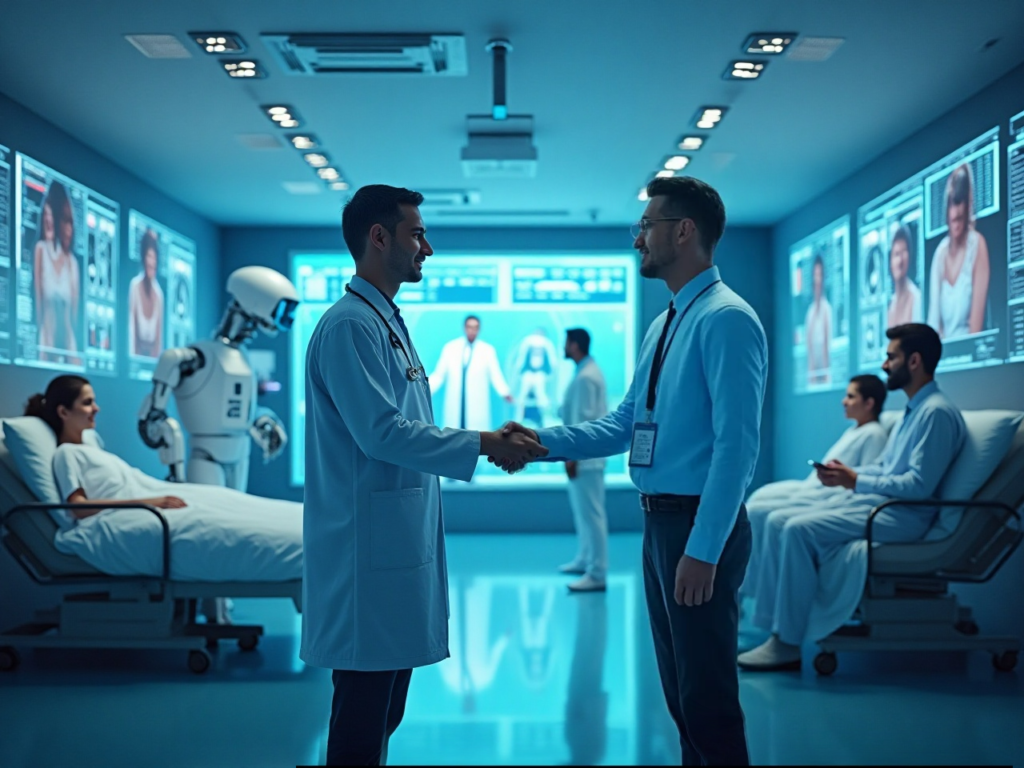The Rise of Technology in Healthcare
-By Team Policy Era
The Invisible Doctor:

The Indian healthcare sector is undergoing a rapid transformation, driven by cutting-edge technologies, government initiatives, and the increasing adoption of digital platforms. From AI to telemedicine, the healthcare system is evolving to become more accessible, affordable, and efficient. Below, we break down the key healthcare technology trends shaping 2025 and beyond.
- HEALTHCARE TECHNOLOGY TRENDS 2025
AI-Powered Diagnostics: Increasing reliance on AI for radiology, pathology, and early disease detection.
Remote Patient Monitoring (RPM): Wearable devices and home health kits enabling real-time health tracking.
Blockchain in Healthcare: Securing patient data and ensuring privacy through decentralised ledgers.
Robotic Surgery: Precision-based surgeries with the assistance of robots like Da Vinci systems are gaining traction.
Healthcare Apps: More Indians are using mobile apps for tracking health, fitness, and even mental well-being.
Cloud-Based EHR Systems: Cloud technology is helping hospitals store and manage Electronic Health Records efficiently.
Digital Therapeutics: Use of software-based interventions to prevent, manage, or treat medical conditions.
5G-Enabled Medical Devices: Faster data transmission allows seamless teleconsultations and data sharing.
- HOW AI IS TRANSFORMING HEALTHCARE
Diagnosis and Imaging:
o AI algorithms now read X-rays, CT scans, and MRIs with high accuracy.
o Tools like Qure.ai are already being used in Indian hospitals for TB and stroke detection.
Drug Discovery:
o AI models speed up the process of identifying new drug compounds.
o Indian pharmaceutical startups are integrating AI to reduce R&D costs.
Predictive Analytics:
o AI is being used to predict outbreaks and patient readmission risks.
o Helps in early interventions and personalized treatment planning.
Virtual Health Assistants:
o Chatbots and virtual nurses provide 24x7 support to patients for medication reminders and FAQs.
Administrative Efficiency:
o AI handles routine tasks like appointment scheduling and medical coding, freeing up human resources for clinical duties.
- IMPACT OF TECHNOLOGY ON PATIENT CARE
Personalized Treatment:
o Genomics and AI help in tailoring treatment based on patient-specific data.
Better Patient Engagement:
o Digital platforms allow patients to access test results, consult doctors, and track progress from anywhere.
Accessibility in Rural Areas:
o Mobile health units and teleconsultation apps are reaching remote parts of India.
Faster Response Time:
o Real-time alerts and automated workflows help doctors act faster in critical situations.
Enhanced Communication:
o Secure messaging and video calls improve doctor-patient relationships and follow-ups.
- DIGITAL HEALTH INNOVATIONS IN 2025
Ayushman Bharat Digital Mission (ABDM):
o Every citizen to have a unique digital health ID, streamlining medical records nationwide.
Smart Hospitals:
o Automation in ICU monitoring, robotic dispensaries, and AI-driven logistics is becoming a norm.
Voice-based interfaces:
o Voice commands to access medical data or update EHRs now simplify doctor workloads.
Mobile Health Vans with IoT:
o Equipped with diagnostic tools, internet connectivity, and solar power, these vans are revolutionizing healthcare outreach.
AI-Based Mental Health Support:
o Platforms like Wysa and YourDOST provide AI-driven emotional support and therapy tools.
AR/VR for Training and Therapy:
o Use of augmented and virtual reality for surgery simulation, PTSD therapy, and rehabilitation.
- TECH-DRIVEN RISK MANAGEMENT IN HEALTHCARE
Proactive Risk Identification:
o Predictive algorithms analyse patient data to identify high-risk cases before complications arise.
Infection Control Systems:
o AI monitors hand hygiene compliance, PPE usage, and infection hotspots in hospitals.
Real-Time Monitoring:
o IoT devices alert doctors about critical vital deviations, minimizing emergencies.
Compliance Automation:
o Technology ensures hospitals meet NABH standards and government protocols through automated checklists and alerts.
Cybersecurity Tools:
o As digital records rise, so do threats. Indian hospitals are increasingly investing in robust cybersecurity systems.
- MEDICAL ERROR REDUCTION WITH AI AND AUTOMATION
Automated Prescription Checks:
o AI systems detect potential drug interactions or dosage errors before prescriptions are finalized.
Barcode and RFID Systems:
o Used to track patient medications and ensure right-patient, right-drug practices.
Clinical Decision Support Systems (CDSS):
o Offers AI-driven suggestions during diagnosis and treatment, reducing reliance on memory or guesswork.
Automated Documentation:
o Voice-to-text EHR entries help doctors avoid manual entry errors.
Standardized Protocols via AI:
o Machine learning models enforce uniform treatment paths across hospitals to minimise human variation.
- HOW TELEMEDICINE IS CHANGING HEALTHCARE DELIVERY
Increased Access to Specialists:
o Rural patients can consult city-based super-specialists via video calls, reducing the need for travel.
Time and Cost Efficiency:
o Saves time for both patients and doctors and reduces infrastructure burden.
Mental Health Services:
o A major area of telehealth growth, offering therapy and counselling remotely.
E-Prescriptions and Digital Pharmacies:
o Online consultations followed by home delivery of prescribed medications is becoming the norm.
Government Push:
o Platforms like eSanjeevani are now serving lakhs of patients, especially during emergencies and pandemics.
- THE ROLE OF BIG DATA IN HEALTHCARE RISK PREVENTION
Population Health Management:
o Analysis of large datasets helps in identifying health trends, disease outbreaks, and demographic-specific risks.
Clinical Trials and Research:
o Big data accelerates trials by analysing real-world evidence and historical data.
Insurance Risk Assessment:
o Helps insurers create personalised premiums and predict claim patterns, thereby reducing fraud.
Hospital Resource Planning:
o Predicting bed occupancy, oxygen needs, and medicine stock using past usage data.
Chronic Disease Management:
o Continuous tracking and intervention planning for diseases like diabetes, hypertension, and cancer.
CONCLUSION
The intersection of healthcare and technology in India is ushering in a new era of innovation, accessibility, and precision. Whether it's AI-led diagnostics, telemedicine consultations, or big data analytics, these advancements are not just futuristic concepts but active components of today's healthcare system.
As we move into 2025, India is set to become a global example of how technology can democratise healthcare, reduce errors, and build a more resilient and inclusive system.

